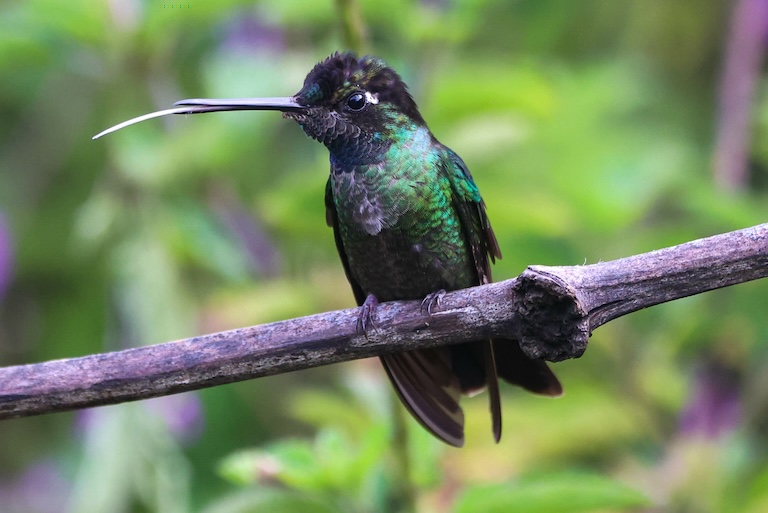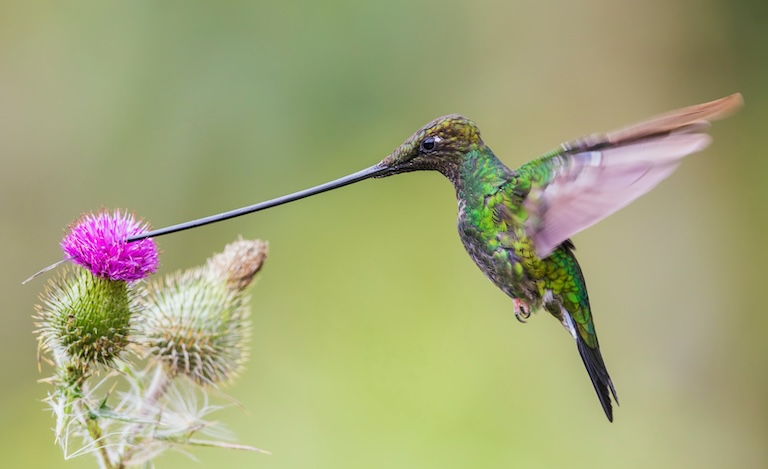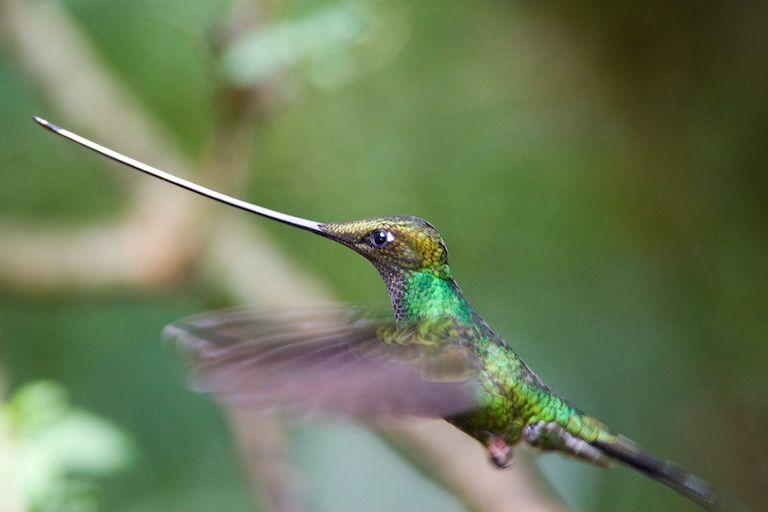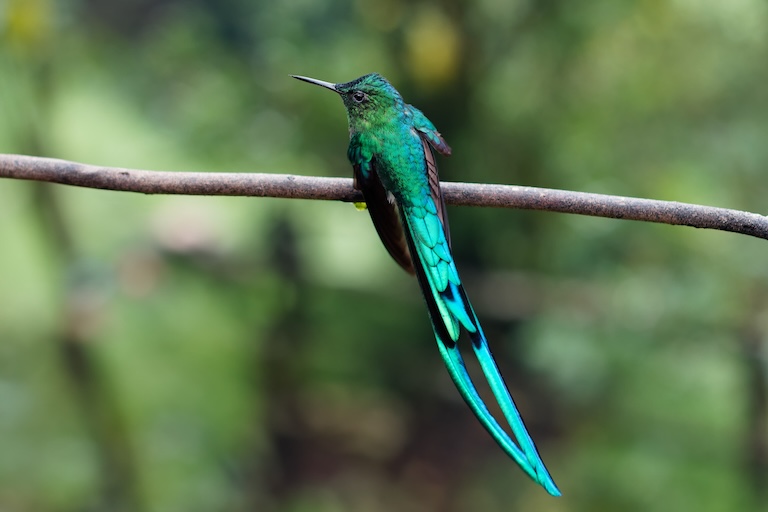Sword-billed Hummingbird Profile
South America has some of the most fascinating and diverse groups of birds on Earth, and the vastly different landscapes and climates on the continent have contributed to this.
There are more than 360 hummingbird species in the Americas, having evolved and radiated from their starting point in South America to cover almost every ecosystem, and in every case, help shape it.
And this is particularly obvious in the species with the longest beak. Named the sword-billed hummingbird (presumably by someone who has never seen a sword before), this small bird has left its mark on the plant life it interacts with.

Sword-billed Hummingbird Facts Overview
| Habitat: | Andean, mountainous, from 1,700–3,500 m (5,600–11,500 ft) |
| Location: | South America |
| Lifespan: | 1-5 years |
| Size: | 14 cm (5.5 in) long, with a 12 cm (4.7 in) beak |
| Weight: | 15 g (0.53 oz) |
| Colour: | Bronze-green on the back, metallic green underneath |
| Diet: | Nectar |
| Predators: | Larger birds, snakes, cats |
| Top Speed: | Not recorded |
| No. of Species: | 1 |
| Conservation Status: | Least Concern (IUCN) |
The Sword-billed hummingbird has the longest beak of any bird, relative to its size. This may look more like a fencing foil than any kind of real sword, but it’s certainly just as specialised.
These brilliant hummingbirds feed routinely on nectar, to the point that they have evolved alongside their host flowers, both species now exhibiting extreme adaptations that cement their relationship.
Interesting Sword-billed Hummingbird Facts
1. They’re brilliants
Birds as tiny and delicate are difficult to identify from the limited fossil record they leave behind, but it’s thought that hummingbirds split from their closest relatives and common ancestors with modern swifts around 35 million years ago, in the region that is now Germany.
At the time, this region had a climate very much like the Caribbean is now, and it remains a bit of a mystery just how they changed from these ancient birds in Germany to what they became 25 million years later – far closer to what we know now in the Americas.
Regardless of how it happened, hummingbirds have radiated into an impressively diverse range of species, making up the 338 known today, choosing nectar over the insect-based preference of their swift cousins.
These species are grouped into two tribes: the Lesbiini, or “coquettes”, and the Heliantheini, or “brilliants”.
There are 53 species of brilliants, and this one is particularly brilliant for what’s sticking out of its face. 1

2. Its beak is really long
Of all 338 known species of hummingbirds, this one has the largest beak, and relative to its body size, it’s the largest beak of any bird at all.
The sword-billed hummingbird is alone in its genus, seemingly ostracised for being the only species to have a beak that’s longer than its body. But this is a tool, and a good one at that.
This beak is so long it can’t be used for cleaning and preening – the bird has to use its feet for that – but it is used to great effect to drink nectar, and being so long, it can drink from exceptionally long flowers.
This allows both the flower and the hummingbird to have a bit of an exclusive relationship. 2
3. They’re specialists
Much like Darwin’s moth, the sword-billed hummingbird has evolved alongside a very particular flower.
Insects and birds are important pollinators to most flowers and while some are less picky about what they eat, the ones with a particular taste end up forming relationships that last millions of years and are reflected in their morphologies.
This little bird has such a long beak precisely because it feeds on an equally long flower, which itself is so long precisely because it needs the hummingbird, and only the hummingbird, to pollinate it.
This form of co-evolution happens in many organisms, but rarely are the organisms involved so few. Often a plant will have a host of pollinators, and in this instance, the periods of feeding appear to be strictly regulated. 3
4. Trap-line feeding
In animal behaviour, trap-line feeding is the name given to the way insects, birds, bats and other fruit or nectar-feeding animals visit their chosen flowers in a repeated, predictable way.
These birds follow such a specific feeding route, pollinating each flower as they go, and this is a great way to avoid competition.
If your competitors know and avoid your daily commute, you never have to get into each other’s way, and vice versa. Competition is costly in terms of energy and the potential danger that comes with it, so avoiding it in clever ways is the path of least resistance.
It’s also less costly in terms of the resources needed to defend territories. Despite the name, the sword-billed hummingbird has little in the way of evolutionary weaponry to claim its space and instead spends its character points on being really good at feeding.

5. But they also eat insects
But while the relationship appears to be fidelitous on behalf of the flower, there’s some side action occasionally spotted from the bird.
While flowers are by far the preferred source of carbohydrates, the hummingbird is known to occasionally take a high protein meal of insets, for which it channels its inner swift and catches on the wing.
6. They invented a passionflower
Still, the powerful relationship between the bird and its chosen flower, the passionflower Passiflora mixta is the sole reason for the latter’s existence.
This flower is so reliant on the bird that it has evolved to defend against more, potentially damaging pollinators and create a flower that’s only accessible to the bird.
As a result, the shape of the hummingbird has been the selective pressure in the design of the flower, and if they were to change or disappear, it’s certainly plausible that the species of plant would go entirely extinct. 4

Sword-billed Hummingbird Fact-File Summary
Scientific Classification
| Kingdom: | Animalia |
| Phylum: | Chordata |
| Class: | Aves |
| Order: | Apodiformes |
| Family: | Trochilidae |
| Genus: | Ensifera |
| Species: | ensifera |
Fact Sources & References
- Jimmy A. McGuire (2014), “Molecular Phylogenetics and the Diversification of Hummingbirds”, Current Biology.
- “Sword-billed Hummingbird”, Cornell Lab.
- ANNIKA BÜCHERT LINDBERG (2001), “The fragility of extreme specialization: Passiflora mixta and its pollinating hummingbird Ensifera ensifera”, Cambridge University Press.
- S Abrahamczyk (2014), “Escape from extreme specialization: passionflowers, bats and the sword-billed hummingbird”, PubMed Central.
